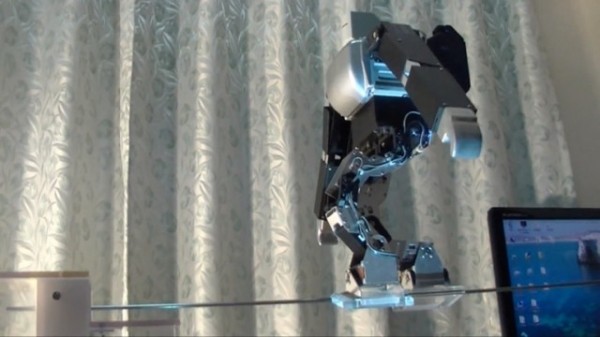Humanoid robots, with their striking resemblance to humans, have captivated the public imagination. However, mimicking the elegance and grace of human locomotion presents a formidable engineering challenge. One of the primary obstacles lies in achieving stable walking, a task that seems effortless for us but demands intricate coordination and balance control for robots. This article delves into the complexities of humanoid robot stability, exploring the key challenges and innovative techniques employed by researchers to develop more robust and reliable walking machines.

The Balancing Act: Why Robot Stability is Paramount
Human balance relies on a sophisticated interplay of sensory feedback, proprioception (awareness of body position), and motor control. We effortlessly adjust our stance, distribute weight, and react to unexpected disturbances to maintain uprightness. Replicating this intricate dance of mechanics and perception in robots is no mean feat.
For humanoid robots, stability is crucial for several reasons:
Safety: Robots operating in shared environments with humans need to be robust and predictable to avoid accidental collisions or harm.
Functionality: Successfully navigating complex terrains and interacting with the world requires stable locomotion. A robot that frequently loses its balance cannot effectively perform tasks or explore intricate spaces.
Natural Interaction: Stable walking is essential for robots to appear natural and lifelike, facilitating smoother human-robot interaction.
Core Challenges: Unveiling the Stability Maze
Developing stable humanoid robots presents numerous technical hurdles:
1. Dynamic Locomotion: Walking involves continuous, dynamic movements with shifts in weight and momentum. Robots must adapt in real-time to maintain balance during these intricate transitions.
2. Sensorimotor Integration: Accurately sensing the robot’s position, velocity, and external forces, and translating this information into appropriate motor commands for balance control, is a complex challenge.
3. Model Accuracy: Robots must possess accurate models of their own body dynamics and the external environment to predict the consequences of their movements and make appropriate adjustments.
4. Actuator Limitations: Robots typically rely on electric actuators, which have limitations in terms of torque, range of motion, and power.
5. Computational Complexity: Implementing real-time balance control algorithms that manage the necessary computations and sensor feedback adds another layer of complexity.
Strategies for Stability: Navigating the Path Forward
Researchers are employing diverse strategies to enhance the stability of humanoid robots:
1. Optimal Control:
Using advanced optimization algorithms to calculate the optimal joint torques and movements for maintaining balance over time.
2. Feedback Control:
Implementing feedback loops that continuously monitor sensor data and make real-time adjustments to motor commands to counterbalance disturbances.
3. Adaptive Control:
Developing control methods that learn and adapt to changes in the robot’s environment and its own dynamic characteristics.
4. ZMP Control:
Manipulating the Zero Moment Point (ZMP), a virtual point representing the balance center, to ensure it remains within the robot’s base of support, preventing toppling.
5. Passive Dynamic Control:
Utilizing passive elements like springs and dampers in the robot’s design to assist in maintaining balance and energy efficiency.
6. Terrain Adaptation:
Developing algorithms that allow robots to adjust their gait and balance control based on the type of terrain they are traversing.
7. Distributed Control:
Dividing control tasks across multiple processors or actuators for improved redundancy and fault tolerance.
Hardware Innovations: Strength from Within
Along with advanced control algorithms, hardware advancements play a crucial role in enhancing robot stability:
Lightweight Materials: Utilizing lightweight yet robust materials like carbon fiber and composites reduces the overall robot weight, making it easier to balance.
Actuator Improvements: Developing more powerful and responsive actuators with wider ranges of motion and improved torque capabilities improves dynamic control.
Sensor Enhancements: Incorporating more sophisticated and accurate sensors, such as inertial measurement units (IMUs), pressure sensors, and force sensors, provides richer feedback data for more precise balance control.
FAQ: Addressing Common Questions about Robot Stability
1. What is the biggest challenge in achieving humanoid robot stability?
The biggest challenge is replicating the complex sensorimotor integration and real-time adaptation capabilities of humans. Robots need to accurately perceive their surroundings, their own body state, and dynamically adjust their movements to maintain balance.
2. How do researchers measure robot stability?
Stability is often measured using metrics such as the Zero Moment Point (ZMP) – the point where the sum of external torques acting on the robot equals zero. Keeping the ZMP within the robot’s base of support is crucial for stability.
3. Are there any humanoid robots known for their outstanding stability?
Several humanoid robots have demonstrated impressive stability, including Boston Dynamics’ Atlas and Honda’s ASIMO. These robots utilize advanced control algorithms and sophisticated hardware to achieve remarkably stable locomotion.
4. How can we expect robot stability to improve in the future?
Continued research in areas like optimal control, AI-powered learning, and bio-inspired design will likely lead to significant advancements in robot stability. We can expect to see robots that are not only more stable but also more adaptable to diverse environments and more capable of interacting safely with humans.
Conclusion: A Steady Step Towards the Future
Enhancing the stability of humanoid robots is a multifaceted challenge that demands innovative solutions from various disciplines. Through advancements in control theory, hardware design, and sensor technology, researchers are steadily making progress towards creating robots that can walk, balance, and interact with their surroundings with greater dexterity and confidence. As these technologies mature, we can anticipate a future where stable humanoid robots become increasingly integrated into our lives, assisting us in a myriad of tasks and enriching our interactions with the world around us.
Closure
Thus, we hope this article has provided valuable insights into Walking the Tightrope: Enhancing Stability in Humanoid Robots. We thank you for taking the time to read this article. See you in our next article!
